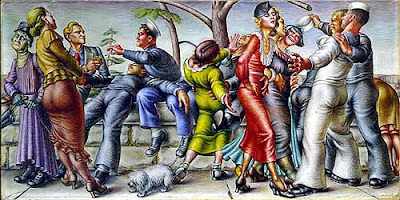Cadmus was born in 1904 New York City into a family of commercial artists. At 15, before he finished high school, he was enrolled in art classes at the National Academy of Design, where he won numerous prizes and scholarships. Cadmus worked at advertising jobs until 1931 and studied at the Art Students League, where he met the painter Jared French, who became his lover and urged him to quit commercial art. In 1931, Cadmus made one of his first paintings depicting French. The painting, Jerry (illustrated above), remained in the French family until recently, when it was acquired by the Toledo Museum of Art. The painting is strikingly intimate; French holds a copy of James Joyce's Ulysses, then banned in the United States for being obscene.
After hopping an oil tanker to Europe and cycling through France and Spain, Cadmus and French settled on the island of Majorca (1931-1933), where Cadmus painted two of his best-known early works, YMCA Locker Room and the Bicyclists (later bought by Cole Porter). After his return to New York in 1933, Cadmus became the center of a circle of gay artists including his brother-in-law, Lincoln Kirstein (who helped found the American School of Ballet), Pavel Tchelitchew, and photographer George Platt Lynes (for whom Cadmus frequently modeled). At the time, he worked for the Public Works of Art Project, which was later incorporated into the WPA. This experience was to help shape his style for the rest of his long career. Nearly illustrative, his paintings remained linked to a realist style found in many WPA works of the 1930s.
In 1934, Cadmus' painting, The Fleet's In, depicted the pleasures of uniformed sailors; it was removed from an exhibition at the Corcoran Gallery in Washington because of complaints by Navy officials (the Corcoran also infamously removed Robert Mapplethorpe's pictures in the 1980s). This "disreputable drunken brawl" came from "the sordid, depraved imagination of someone who has no conception of actual conditions in our service", fumed Secretary of Navy Claude Swanson. Like a stealth cruiser, The Fleet was kept from public view until 1981 and is now temporarily displayed at the Navy Art Gallery in Washington, DC. The tight, butt and crotch clinging clothing on the soldiers leaves little to the imagination (click to enlarge).
In 1937 Cadmus’s lover Jared left him to marry a mutual friend, Margaret Hoening. The three of them remained close friends, however, and worked together on a number of photography projects. Throughout the late 1930s Cadmus continued to shock. Murals commissioned for a post office were rejected as "unsuitable for a public building", and in 1939 he once again depicted drunken sailors, causing “Sailors and Floozies” to be removed from the Golden Gate International Exhibition in San Francisco. A mural hung in 1939 in a Richmond, VA, post office depicted an event important in the state's history, The Rescue of Capt. John Smith by Pocahontas; while it contains an image of Pocahontas with a bared breast, and the bare buttocks of a male Indian, Cadmus was ordered to retouch the prominent and suggestive crotch area of another male Indian figure (figure below; click to enlarge).
Despite the stream of rejections and controversies, the 1930s and 1940s were Cadmus' most successful years. Professionally, he was at his peak, and his social life was an endless whirl of glamorous Manhattan parties with friends, including W.H. Auden, Christopher Isherwood, Edith Sitwell, George Platt Lynes, and E.M. Forster. In the post-war 1940s he had been involved with artist George Tooker but the relationship was over by 1949. Cadmus once again found love in 1964 when he met Jon Andersson, a singer and actor who became his partner for the next 35 years.
Manikins (1951)
The Bath (center)
Stone Blossom: A Conversation Piece (1939)
Cadmus was a slow, meticulous worker who favored the complicated, time-consuming medium of egg tempera. He finished an average of only two paintings a year. He was more prolific in other media, including drawing, printmaking and photography. Although Cadmus stopped painting toward the end of his life, he continued to draw at his home in Weston, Connecticut, particularly portraits and figure studies of his partner Jon Andersson. Paul Cadmus died in his home in Weston in 1999, just five days short of his 95th birthday.
Role models of greatness.
Here you will discover the back stories of kings, titans of industry, stellar athletes, giants of the entertainment field, scientists, politicians, artists and heroes – all of them gay or bisexual men. If their lives can serve as role models to young men who have been bullied or taught to think less of themselves for their sexual orientation, all the better. The sexual orientation of those featured here did not stand in the way of their achievements.
Sunday, September 11, 2011
Subscribe to:
Post Comments (Atom)






Loved him
ReplyDelete